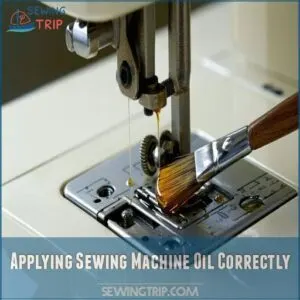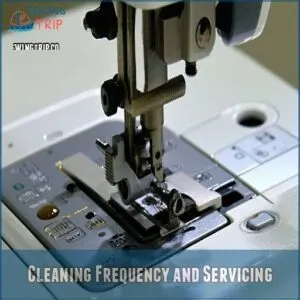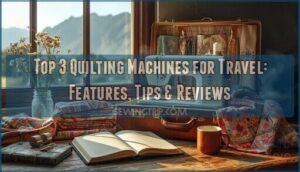This site is supported by our readers. We may earn a commission, at no cost to you, if you purchase through links.
 To oil a sewing machine, first unplug it and gather a lint brush, sewing machine oil, and a soft cloth.
To oil a sewing machine, first unplug it and gather a lint brush, sewing machine oil, and a soft cloth.
Remove the needle, thread, and bobbin, then clean out lint and dust, especially in the bobbin case and under the needle plate.
Use your manual to locate key oiling points like the hook race and needle bar—apply just a drop of sewing machine oil to each spot.
Avoid over-oiling; a little goes a long way! Wipe away excess oil, then run the machine briefly to spread it evenly.
A well-oiled machine works like a dream—just remember, regular care prevents costly repairs!
Table Of Contents
Key Takeaways
- Unplug your sewing machine and remove the needle, thread, and bobbin before starting. Clean lint and dust from key areas like the bobbin case and under the needle plate.
- Use sewing machine oil sparingly on key moving parts like the needle bar and bobbin case, following your manual for precise oiling points.
- Wipe off excess oil thoroughly and run the machine briefly to distribute lubrication evenly and ensure smooth operation.
- Schedule regular cleaning every few months, depending on usage, and get professional servicing annually to prevent wear and costly repairs.
How to Oil a Sewing Machine?

Oiling your sewing machine isn’t rocket science, but it does take care and precision.
Before you start, make sure you’ve been following proper thread tension guidelines to avoid any machine damage.
Start by unplugging the machine—safety first! Clean it thoroughly using cleaning tools like a lint brush or compressed air.
Next, consult your manual to locate oil points, such as the needle bar or bobbin area. Apply a small drop of sewing machine oil—don’t overdo it!
Run the machine briefly to evenly distribute the lubrication. Finally, wipe away excess oil with a soft cloth.
Regular sewing machine maintenance, including proper sewing machine lubrication, guarantees smooth stitching and prevents avoidable wear on your machine’s moving parts.
Preparing Your Sewing Machine for Cleaning
Before cleaning, unplug your sewing machine.
Gather all required tools like a lint brush, tweezers, and a soft cloth.
Clearing your workspace and protecting it makes certain you’re ready to tidy without damaging anything.
Gathering Necessary Materials
Before you oil your sewing machine, gather everything you’ll need. You can purchase the necessary supplies, including sewing machine oil, online at places like Everysimply. Being organized saves time and makes the cleaning process a breeze.
Start by grabbing these essentials:
- Sewing Machine Oil: Stick to manufacturer-recommended oil types. Avoid household oils like WD-40—they’re not designed for sewing machine lubrication and can cause damage.
- Soft Cloths: Use lint-free fabrics to wipe away excess oil and clean each part thoroughly without leaving fibers behind.
- Tweezers: Perfect for reaching and removing stubborn lint trapped in tiny crevices.
- Workspace Prep Tools: Place towels or layers of newspaper under your machine to catch spills or stray lint. Nobody wants oil on their dining table!
- Sewing Machine Manual: Your go-to guide for specific cleaning and oiling areas.
Using smart storage solutions like labeled bins can help keep your tool checklist organized. Take a few minutes to prep—your sewing machine will thank you every time it hums smoothly.
Safety Precautions
Cleaning your sewing machine isn’t just about getting rid of lint—it’s about doing it safely. Here’s what you need to know before you get started:
- Unplug first: Electrical safety is a must. Always unplug your machine to avoid any shocking surprises.
- Grab those glasses: Eye protection isn’t optional. Tiny bits of lint and oil can go flying, so shield your eyes like a pro.
- Wear gloves: Skin protection matters; gloves help keep your hands safe from sharp parts and messy oil spills.
- Ventilate the room: Proper ventilation is key, especially if you’re using cleaning chemicals. A sunny, open space can do wonders.
- Distance your compressed air: Keep it 4 inches away. Too close, and that high-pressure air might damage delicate parts.
- Control oil spills: Wipe away excess with a clean cloth. Sewing machine oil is amazing for lubrication, but not on your projects!
Taking these safety steps? You’ll enjoy a smoother, safer sewing machine maintenance process—no stitches needed (pun intended). After all, a safe start leads to flawless results in your sewing machine care routine.
Step 1: Remove Lint Buildup
Before you start oiling, clear out lint and debris to keep your machine running smoothly. A clean machine guarantees better stitching and prevents unnecessary wear.
Using Compressed Air for Deep Cleaning
Compressed air is your secret weapon for sewing machine maintenance.
When lint piles up in tricky spots, follow these steps:
- Safety tips first: Unplug the machine, remove the needle, and clear away thread to avoid damage.
- Control air pressure: Keep the nozzle at 4+ inches, angling it to blast debris out without pushing it further in.
- Use proper attachments: A brush or vacuum nozzle helps target sewing machine parts for thorough cleaning results. For maximum cleaning, consider using a sewing machine air duster.
Consistent lint removal guarantees smoother stitches!
Importance of Regular Lint Removal
Got lint? It’s the silent villain sabotaging your sewing machine’s performance. Lint buildup can lead to skipped stitches, thread breakage, or worse, a total jam. Regular lint removal is key to keeping your sewing machine running smoothly.
Start by unplugging the machine, then pull out the needle, thread, and bobbin.
Grab a brush or tweezers to sweep away buildup, focusing on the bobbin case, under the needle plate cover, and the bobbin compartment.
For a deeper clean, aim compressed air at an angle to push lint out instead of trapping it.
Stick to a cleaning schedule—every 5-10 days for busy sewers or every six months for occasional use—and avoid lint-related headaches entirely!
Step 2: Oiling Your Sewing Machine
Now it’s time to oil your sewing machine to keep it running smoothly and quietly. Focus on applying small amounts of oil to the correct parts to avoid over-lubrication.
Identifying Oiling Locations
Curious where to apply sewing machine oil? Start with key lubrication spots for silky-smooth stitching. Focus on these:
- Bobbin Housing: The "hub" where threads unite—don’t forget this critical part.
- Shuttle Hook: Keeps the stitches flowing; it’s the MVP of moving parts.
- Moving Mechanisms: Peek inside to locate gears and joints your manual highlights.
An oiling chart from your manual is your ultimate sewing machine oiling guide.
Applying Sewing Machine Oil Correctly
When applying sewing machine oil, focus on moving parts like the bobbin housing and shuttle hook. Always use sewing machine oil for proper lubrication and to protect your machine.
A small brush or cloth guarantees precise application, limiting spills and stains—less is more.
Regular maintenance like cleaning and greasing every 6 months can help prevent issues like upside-down stitching.
Stick to the recommended oil quantity and oiling frequency in your manual.
Afterward, wipe excess oil to prevent fabric stains.
This sewing machine oiling guide keeps your workspace clean and your machine running smoothly.
Troubleshooting Common Oiling Mistakes
- Misplaced Oil: Precision matters—oil the right spots to avoid skipped stitches and fabric stains.
- Over-Oiling Problems: Excess oil can lead to fabric blemishes. Run scrap fabric, like muslin, through your machine to clear extra residue.
- Cleaning Residual Oil: If oil touches fabric-contact parts, wipe with a soft cloth and sewing machine oil. Regular maintenance prevents noisy performance or worn parts.
Cleaning Frequency and Servicing
Keeping your sewing machine clean and serviced regularly is essential to maintain its performance and prevent costly repairs.
Adjust your cleaning schedule based on how often you sew.
Annual professional maintenance is also important and should not be skipped.
Determining Your Cleaning Schedule
How often should you clean your sewing machine? It depends on your usage.
If you’re a frequent sewer, clean it every 5–10 days. Regular users should aim for weekly maintenance, while occasional crafters can clean monthly.
For less frequent use, every six months is fine.
Routine sewing machine upkeep keeps lint at bay, extends lifespan, and maintains smooth operation during creative projects.
The Importance of Professional Servicing
Keeping your sewing machine in tip-top shape isn’t just about oiling and wiping it down; professional servicing is key for long-term performance. Neglect regular maintenance, and you’re inviting problems like sluggish parts, skipped stitches, or even costly repairs. For those looking to take their machine care to the next level, investing in order to maintain optimal performance, investing in a sewing machine service kit can be a great starting point.
Here’s why springing for expert care pays off:
- Cost-Benefit Analysis: While a professional tune-up costs $75 to $100, it prevents big, pricey issues like a seized motor or misaligned mechanism can set you back far more than regular servicing. Think of it as preventative maintenance that keeps your machine running smoothly for years.
- Expert Diagnosis: Professionals can spot hidden problems like worn gears or loose screws that escape the untrained eye. They’ll align timing, and replace worn parts—steps necessary for perfect performance.
- Warranty Implications: If your sewing machine is under warranty, adhering to a consistent service schedule might be required. Skipping this could void your warranty, leaving you on the hook for expensive repairs later.
- Service Frequency: Even the gentlest machine use creates lint buildup, dries out lubricants, or wears moving parts. For heavy users, consider a tune-up every six months to a year to a year. Weekend crafters might stretch a tune-up to a year, while occasional users can opt for less frequent visits.
During professional maintenance, technicians don’t just clean and inspect all moving parts for wear, align components for perfect performance, and keep your machine running like a charm. Regular servicing isn’t just care—it’s insurance against downtime and frustration. Remember, expert help is fewer skipped stitches, no nasty surprises, and smoother projects.
Maintaining Sewing Machine Performance
Keeping your sewing machine in top shape requires regular cleaning and oiling.
These actions help reduce friction and wear.
By addressing minor issues early, you’ll prevent costly repairs.
You’ll also keep your projects running smoothly.
Benefits of Regular Cleaning and Oiling
Regular cleaning and oiling are like a fitness routine for your machine, ensuring it performs at its best. Sewing machine oiling tips include using the right oil to reduce wear and prevent rust. These practices extend your machine’s life, keep it running smoothly, and result in better stitch quality with fewer repairs needed.
Here’s a quick glance at the benefits:
| Benefit | Reason | Result | Frequency |
|---|---|---|---|
| Extended machine life | Reduces part friction | Longer-lasting machine | Every few months |
| Prevents rust | Keeps metal lubricated | Avoids corrosion | As per manual guidelines |
| Smooth operation | Proper lubrication | No thread tension issues | Regular maintenance |
| Better stitch quality | No lint buildup | Clean, precise stitches | Weekly cleaning/oiling |
Keep oiling simple—your machine will thank you by ensuring smooth operation every time you sew!
Signs Your Sewing Machine Needs Servicing
Spotting problems early keeps your sewing machine running like a dream. If it’s showing these warning signs, it’s time to act:
- Noisy bobbin: A sewing machine noisy at the bobbin? Dust or lint might be clogging things up.
- Skipped stitches: Uneven stitches mean tension issues or a worn-out needle.
- Thread breaks: Constant thread breaks often signal a need to clean and lubricate the sewing machine.
Nobody enjoys machine jams or uneven stitches ruining their projects.
Regularly cleaning, using sewing machine oil, and knowing when to seek sewing machine repair help prevent bigger issues.
Stay ahead by keeping everything in top shape, so your creativity keeps flowing smoothly.
Frequently Asked Questions (FAQs)
How do you oil a sewing machine?
Imagine your sewing machine screeching for help; it’s begging for oil.
Unplug it, clean lint and debris,
then apply sewing machine oil sparingly to moving parts.
Wipe excess oil, test stitches, and verify smooth operation.
Do you need to oil a sewing machine?
Yes, you need to oil your sewing machine to keep it running smoothly and prevent wear.
Without oil, friction builds up, causing parts to jam, rust, or break down over time.
How to lubricate a sewing machine?
Keep your sewing machine running smooth by applying a few drops of sewing machine oil to moving parts, like the rotary hook and bobbin case.
Wipe excess oil.
Run the machine briefly, and test stitching.
Why should you oil a sewing machine?
You should oil a sewing machine to keep its moving parts working smoothly, reduce friction, and prevent wear or rust.
Oiling extends your machine’s lifespan.
Oiling guarantees consistent performance and avoids frustrating problems like skipped stitches or jamming.
What is sewing machine oil?
Sewing machine oil is a specially formulated lubricant designed to reduce friction and prevent rust.
It’s lightweight, clear, and non-staining.
Smooth operation for moving parts is ensured without damaging fabric or causing buildup.
How do I know if my sewing machine needs oiling?
If your sewing machine starts skipping stitches, feels stiff while turning, makes unusual noises, or produces uneven tension, it’s likely thirsty for oil.
Regularly check your manual for specific maintenance schedules and oiling points.
Where do I put oil in my sewing machine?
Focus on moving parts like the needle bar, bobbin case, and rotary hook.
Check your manual for exact spots, and use only a drop of sewing machine oil.
Too much can cause fabric stains.
Can WD-40 be used to oil a sewing machine?
No, don’t use WD-40 to oil your sewing machine.
It’s a cleaning agent, not a lubricant, and can damage parts over time.
Stick to sewing machine oil for smooth, safe, and long-lasting performance.
How do you know if your sewing machine needs oil?
You’ll know your sewing machine needs oil when it starts making unusual noises, feels stiff during operation, skips stitches, or shows inconsistent tension.
Regularly check moving parts to catch early signs of friction or dryness.
What oil can I use on my sewing machine?
Stick with sewing machine oil—it’s lightweight, mineral-based, and designed for precision.
Don’t grab WD-40 or cooking oils; they’ll gum things up.
Check your manual, as some machines might use specific brands or alternatives.
Conclusion
When your sewing machine isn’t running smoothly, oiling might be the fix it’s begging for.
Regularly cleaning and learning how to oil a sewing machine keeps it in top shape, cuts down costly repairs, and guarantees your projects flow flawlessly.
Follow your manual, apply the right oil sparingly, and check for dust and dirt buildup—it’s a small effort for a big payoff.
Treat your machine right, and it’ll reward you with years of reliable stitching. Don’t wait, start today!














